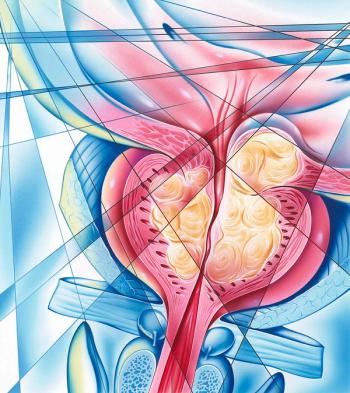
Oncology NEWS International
- Oncology NEWS International Vol 7 No 7
- Volume 7
- Issue 7
Androgen Ablation Added to RT Improves Outcome in Locally Advanced Prostate Cancer
ANN ARBOR, Michigan--The addition of androgen ablation to radiation therapy led to significant improvement in the rate of local failure, distant failure, and disease-free survival, but not overall survival, in men with large-volume, low-grade, locally advanced prostate cancer.
ANN ARBOR, Michigan--The addition of androgen ablation to radiation therapy led to significant improvement in the rate of local failure, distant failure, and disease-free survival, but not overall survival, in men with large-volume, low-grade, locally advanced prostate cancer.
Adjuvant hormonal treatment improved 5- and 8-year outcomes in the multicenter RTOG trial. However, the benefits were limited to patients whose tumors were Gleason grade 2 to 7, Miljenko V. Pilepich, MD, reported at ASCO.
The findings came from a randomized trial of 471 men who had locally advanced prostate cancer stages T2-T4 and no evidence of distant metastases. To qualify for the study, the product of tumor dimensions had to be 25 or more.
Only 8% of patients had positive lymph nodes, a low rate that might have reflected the fact that nodal status was evaluated predominantly on the basis of CT scans, said Dr. Pilepich, a radiation oncologist at St. Joseph Mercy Hospital, Ann Arbor, Michigan.
PSA testing was not available when patient accrual began in 1987 and was added to the workup only in the latter stages of investigation. For the entire study population, 30% of patients had stage T2 cancer and 70% had stages T3-4.
The patients were randomized to receive standard radiation therapy or radiation plus 4 months of hormonal treatment, beginning 2 months before the start of radiation. Hormonal therapy consisted of 3.6 mg of goserelin (Zoladex) every 28 days plus 250 mg of flutamide (Eulexin) three times a day. The radiation dose was 44 to 46 Gy to the regional lymph nodes and 65 to 70 Gy to the prostate.
Median follow-up has reached 6 years for the entire study population and 7 years for patients who remain alive. The investigators defined local disease progression as at least a 50% increase in the product of tumor dimensions. Systematic biopsy was not standard when the trial began, and biopsies were performed only as indicated.
Local Failure Rates
At 5 years, 22% of the combined-treatment arm had experienced local failure, compared with 35% of the control arm. Eight-year local failure rates were 31% and 44%, respectively, for combination treatment and controls. The overall trend significantly favored combination therapy (p = .005).
Distant failure occurred in 29% of the combination arm at 5 years and 35% at 8 years. The distant failure rates for patients who received only radiation therapy were 39% and 45%, respectively, at 5 and 8 years (p = .04).
Disease-free survival was 49% at 5 years and 29% at 8 years in patients who received hormonal therapy plus radiation. At the same time intervals, the disease-free rates were 34% and 21%, respectively, in patients who received radiation therapy alone (p = .005).
Overall Survival
Overall survival also favored patients who received the combination: 97 patients in the combination arm have died vs 119 in the group that received radiation therapy only. However, the difference has not yet reached significance.
Evaluation by tumor grade showed substantial differences between patients whose tumors were Gleason grades 2-7 vs Gleason 8 or higher. Patients with higher Gleason grades derived no significant benefit from combination therapy for any of the survival parameters.
"Looking at the data in this and other RTOG studies, we can conclude that a brief course of hormonal management, given before and during radiotherapy, has a profound effect on tumor progression in Gleason 2-7 patients," he said. "However, to exert its beneficial effect on tumor progression and survival in Gleason 8-10 patients, hormonal management must be administered over a much longer period, at least several years."
Articles in this issue
over 27 years ago
Calling the National Cancer Instituteover 27 years ago
Six Cycles of AT Found Safe in Advanced Breast Cancerover 27 years ago
New Drug Promising in Advanced Pancreatic Cancerover 27 years ago
Herceptin/Chemo Effective in Metastatic Breast Cancerover 27 years ago
Virtual Reality Exhibit Simulates Cancer Fatigueover 27 years ago
New Director of AIDS Researchover 27 years ago
Exhibit Explores Healing Power of Creating Artworkover 27 years ago
Update on Trials of Thrombopoietin for Platelet Recoveryover 27 years ago
Amifostine Reduces Xerostomia After RT for Head and Neck Cancerover 27 years ago
National Survey Documents Gap in Quality of HIV/AIDS CareNewsletter
Stay up to date on recent advances in the multidisciplinary approach to cancer.


















































































